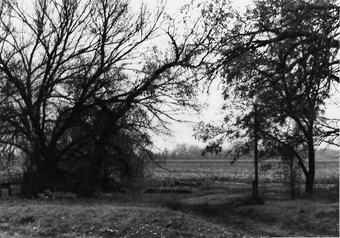Whiteford (Price) Archeological Site facts for kids
|
Whiteford (Price) Archeological Site
|
|

The site in 1975
|
|
| Lua error in Module:Location_map at line 420: attempt to index field 'wikibase' (a nil value). | |
| Nearest city | New Cambria, Kansas |
|---|---|
| Area | 135 acres (55 ha) |
| Built | 1000 |
| NRHP reference No. | 66000350 |
Quick facts for kids Significant dates |
|
| Added to NRHP | October 15, 1966 |
| Designated NHL | July 19, 1964 |
The Whiteford (Price) Archeological Site is an important archaeological site in Kansas, United States. An archaeological site is a place where people lived or did things a long time ago, and we can find clues about their lives there. This site is special because it was a village where people lived in the Central Plains region. It also has a very well-preserved area where people were buried.
The site is known by a special code, 14SA1, which is part of the Smithsonian trinomial system used by archaeologists. It is located in a quiet, rural area between the towns of Salina and New Cambria, Kansas. Because of its importance, the Whiteford (Price) Site has been named a National Historic Landmark. This means it's a place recognized by the U.S. government for its historical value. The site is on private land, so it is not open for people to visit.
Contents
What is the Whiteford (Price) Site?
The Whiteford (Price) Site is found on private land in Saline County, Kansas. It sits in a flat area near the Smoky Hill River and the Saline River. This area is called a flood plain, which means it's a low, flat land next to a river that might flood sometimes.
Archaeologists believe the site was once a small village. In the 1930s, people found twelve to fifteen low mounds here. These mounds were thought to be the remains of old houses. Today, these mounds are gone because the land has been used for farming. However, archaeologists can still find small amounts of old items in the soil. These items are called "cultural materials" and they tell us about the people who lived there.
Scientists have studied the items found at the site. They believe people lived in this village from about the year 1000 CE to 1350 CE. This means the village was active for about 350 years!
How Was the Site Discovered?
The Whiteford (Price) Site was first discovered by accident in 1873. A man named Benjamin Marlin was building a dugout home on his land. A dugout home is a shelter built partly underground. While digging, he found some old bones.
Many years later, in 1936, a couple named Guy and Mabel Whiteford began to dig at the site. For a long time, the site became a place that tourists could visit. It was known as the "Indian Burial Pit" or the "Salina Burial Pit."
In 1964, the site was officially recognized as a U.S. National Historic Landmark. This helped protect it. Later, in 1989, the state of Kansas bought the site. To keep the important burial area safe, it was filled with sand in 1990. Then, it was covered with a concrete cap, and finally with dirt and grass. This was done to protect the historical remains for the future.
What Did a Historical Marker Say About the Site?
There used to be a special sign, called a Kansas Historical Marker, along U.S. Route 40 near the site. This sign told people about the Whiteford (Price) Site. Here is what the sign said:
- Hundreds of years ago, maybe more than a thousand, tall people lived in this valley.
- These people were not the same as the "7-foot warriors" that a Spanish explorer named Coronado saw in 1541. They were an even older group of people.
- They lived in houses made of earth. They farmed, hunted, and fished for food.
- The site has very important archaeological clues about these people.
- About a mile from the sign, there was a burial pit. It held the remains of more than 140 people. These remains showed how big and strong these ancient people were.
- The pit was found in 1936. It was carefully dug up by scientists. The remains were left in the same bent positions they were buried in centuries ago.
- Archaeologists found many items in the pit. These included pieces of pottery, a grinding stone, and old corn and beans. They also found a stone tomahawk, special flint knives, and beads and earrings made from clam shells.
Images for kids


